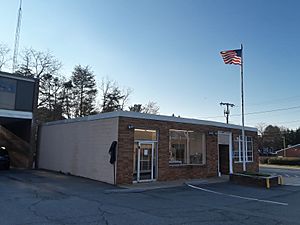Dunn Loring, Virginia facts for kids
Quick facts for kids
Dunn Loring, Virginia
|
|
|---|---|

Dunn Loring post office, April 2019
|
|

Location of Dunn Loring in Fairfax County, Virginia
|
|
| Country | |
| State | |
| County | |
| Area | |
| • Total | 2.4 sq mi (6.1 km2) |
| • Land | 2.4 sq mi (6.1 km2) |
| • Water | 0 sq mi (0.0 km2) |
| Elevation | 436 ft (133 m) |
| Population
(2020)
|
|
| • Total | 9,464 |
| • Density | 3,943.3/sq mi (1,551.5/km2) |
| Time zone | UTC−5 (Eastern (EST)) |
| • Summer (DST) | UTC−4 (EDT) |
| ZIP code |
22027
|
| Area code(s) | 703 |
| FIPS code | 51-23984 |
| GNIS feature ID | 1495484 |
Dunn Loring is a community in Fairfax County, Virginia, United States. It is a "census-designated place" (CDP). This means it's an area defined by the government for counting people, but it's not an official town or city. In 2020, about 9,464 people lived there. Dunn Loring is a suburban area. It is close to Merrifield, Vienna, Tysons, and Idylwood. It is also part of the larger Washington metropolitan area.
Contents
History of Dunn Loring
Dunn Loring was one of the first planned communities in Fairfax County. It was started in 1886. General William McKee Dunn and his wife, Elizabeth Lanier Dunn, bought about 600 acres of land. This land was along a railroad line.
In 1886, the land was given to the Loring Land and Improvement Company. This company included General Dunn, who was a retired Army general. It also included George B. Loring, a former congressman. The company built a railroad station and a post office.
After General Dunn died, the development slowed down. But during the Spanish–American War, a military camp called Camp Alger was built nearby. This brought more people and growth to Dunn Loring. A famous writer and poet named Carl Sandburg trained at Camp Alger. Today, a street in Dunn Loring is named Sandburg Street after him.
Later, in 1912, a man named Fairfax Shield McCandlish took over the development. He divided the land into the way it looks today. After World War II, Dunn Loring grew even more as part of the larger Washington, D.C. area. Until the mid-1990s, some parts of Dunn Loring were still horse farms before more homes and businesses were built.
Geography of Dunn Loring
Dunn Loring is located in the northeastern part of Fairfax County. It is about 14 miles west of downtown Washington, D.C. To its west is the town of Vienna. To the north is Tysons Corner. The Capital Beltway is to the east, and Interstate 66 is to the south.
The area of Dunn Loring is about 6.1 square kilometers (2.4 square miles). All of this area is land. Some small streams that flow all year round, part of Accotink Creek's Long Branch, run through the community.
People in Dunn Loring
| Historical population | |||
|---|---|---|---|
| Census | Pop. | %± | |
| 2000 | 7,861 | — | |
| 2010 | 8,803 | 12.0% | |
| 2020 | 9,464 | 7.5% | |
| 2020 Census Data | |||
In 2020, there were 9,464 people living in Dunn Loring. There were about 2,806 households. The average family household had about 3.27 people.
Most people in Dunn Loring are White (about 59.7%). About 23.8% are Asian, and 4.3% are African American. About 7.4% of the population is Hispanic or Latino.
The average age of people in Dunn Loring was 42 years old. About 23.8% of the people were under 18. About 16.4% were 65 or older. Many people in Dunn Loring have Irish family backgrounds (about 12.5%). About 35.7% of people speak a language other than English at home. Also, about 26.1% of the people were born outside the United States.
The average income for a household in Dunn Loring was about $238,734. For families, the average income was about $246,716. About 4.6% of the people in Dunn Loring had lower incomes. Many adults (78.5%) have a college degree or higher.
Getting Around Dunn Loring
Interstate 66 and Interstate 495 are major roads that help people get to and from Dunn Loring. These roads form the southern and eastern borders of the community.
Dunn Loring is about the same distance from two major airports. It is about 16 miles west of Washington Dulles International Airport. It is also about 12 miles east of Ronald Reagan Washington National Airport. The community also has its own Dunn Loring station on the Washington Metro's Orange Line, which is a subway system.
See also
 In Spanish: Dunn Loring (Virginia) para niños
In Spanish: Dunn Loring (Virginia) para niños





